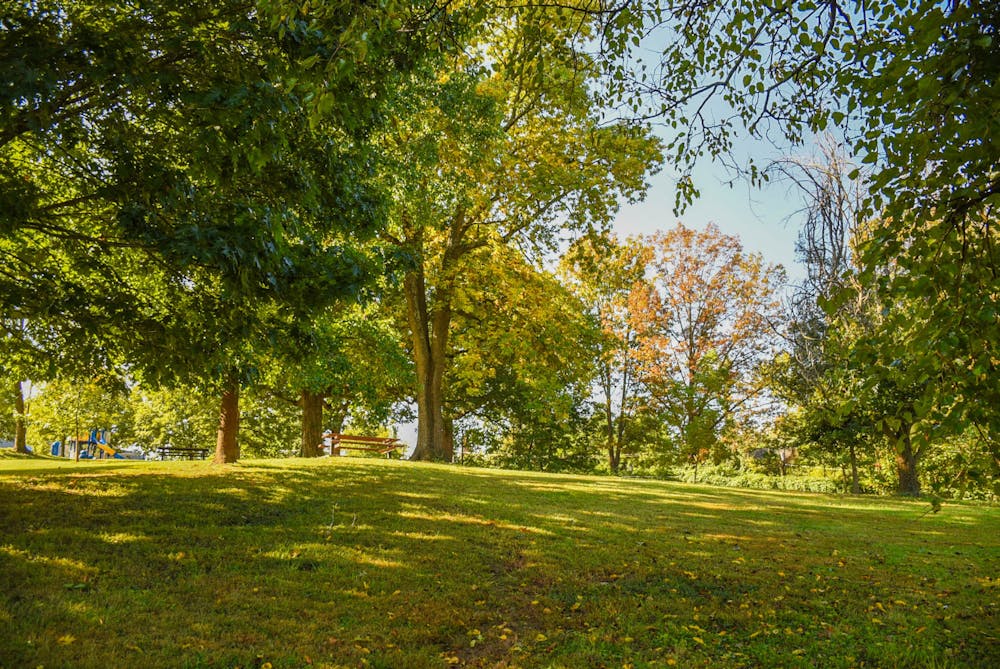Graduate students in the School of Architecture have been working with Cultivate Charlottesville, an organization that centers around combatting food inequality in Charlottesville, to design plans for a proposed community garden in Booker T. Washington Park. Students worked with community members throughout the design process to maximize local impact.
C.L. Bohannon, Cultivate Charlottesville board secretary and Landscape Architecture professor, developed the project along with Landscape Architecture lecturer Rebecca Hinch for their landscape architecture studio course. During the studio, which is a required course for the landscape architecture curriculum, students spent two and a half weeks working in pairs to design plans for the “Power to Grow” campaign.
Bohannon and Hinch’s course focuses on uneven geographies in development, and food insecurity served as an example of one of those inequalities. By partnering with Cultivate Charlottesville, Bohannon hoped his students would contribute to having a positive effect on local food access and health within the community.
“[The garden] can impact generations in terms of healthy eating, getting back into nature, being outside,” Bohannon said. “It was a no-brainer for us in terms of having a direct impact to help address the needs of residents in the Charlottesville area.”
As part of the project, students met with Cultivate Charlottesville members, performed background research on the history of Booker T. Washington Park and discussed the designs with community representatives from the neighborhood surrounding the park.
Bohannon also said he wanted the students’ projects to focus on designing more than simply a farm for gardening. Beyond functional elements like drainage and solar orientation, students were encouraged to consider accessibility, how the area would be used for green space and how it could be transformed into a social gathering spot in their designs. Cultivate Charlottesville also requested that local artwork be included in the plans, as a way to further the project’s connection to the community.
In the culmination of the project, Cultivate Charlottesville presented the students’ designs at the City Council hearing Sept. 19.
Although the plans are not final, the designs served as a way for Cultivate to demonstrate the feasibility of the garden project to City Council. Brian Van, second-year graduate Urban Planning Architecture student, said that he and his class partner, Lysette Velazquez, third-year graduate Landscape Architecture student, hoped to show the garden’s potential benefits to the community.
“[Cultivate Charlottesville was] looking for ideas to really show and prove that having a community garden there is feasible, it is possible,” Van said.
Many members of the University involved in the partnership with Cultivate Charlottesville feel that the garden project’s importance also goes beyond practical function. Given Booker T. Washington Park’s complex history, creating a communal gathering space for the predominantly Black neighborhood is another important aim of the project.
Once a plantation, the land on which the park now stands fell into disuse after the Civil War. The area then became a dumping site for the city of Charlottesville — and remained a landfill until it was designated as the city’s “Blacks only” segregated park.
Julia MacNelly, second-year Landscape Architecture student, who is also taking the studio course, emphasized the importance of reclaiming the space.
“Charlottesville isn’t segregated anymore, but that doesn’t mean that all spaces feel welcoming for Black members of the community,” MacNelly said. “I think the design of [Cultivate Charlottesville’s project] would explicitly be to find a little piece of community that really does feel welcoming.”
The local support is overwhelming — over 90 percent of community members are in favor of the urban agricultural garden, according to Bohannon.
When students were creating their designs, Bohannon and Hinch brought in local representatives and members of Cultivate to voice the wants and needs for the garden space from the perspectives of a variety of community members.The project centered heavily on understanding the needs of the local Charlottesville community, and bringing to life their vision of the garden space.
“It was about using dialogue as a way to understand community needs, so the first thing was to listen,” Bohannon said.
Partnerships like this one align with the curricular endeavors within Architecture to teach students not only technical skills, but how those skills can be used to help the community in which they are being educated, according to Hinch.
“That’s not typical of every design program in the country, or certainly the state, so it’s awesome that students have the opportunity to do that in a responsible, caring way,” Hinch said. “I think it was empowering for [the students] to learn that as designers, they have skills that people in their immediate community could benefit from.”
Although the design project in the studio class only lasted a few weeks, students of the University will continue to serve Cultivate Charlottesville through Bohannon’s Community Engagement lab. Bohannon hopes that through the lab, the project may be able to take on a more interdisciplinary approach by involving students beyond the School of Architecture.
“I'm impressed by the students at U.Va. that are getting out into the community with a passion,” Bohannon said. “I feel fortunate as a faculty member to be surrounded by folks that actually want to have a better society.”







